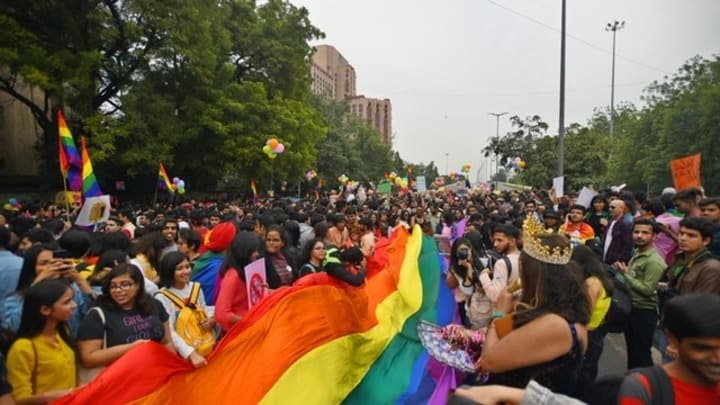52 years of Pride
LGBTQIA+ and Mental Health in India

Where are we?
Over 50 years have passed since the Stonewall Uprising in 1969. How far has India come?

While looking for information about the LGTBQ+ community and mental health care, I came across only a handful of epidemiological studies. Additionally, many such studies seem to misrepresent transgender persons. Discourses around sexuality and LGBTQ+ rights are gaining traction in socio-political and academic spheres. However, since any systematic data for the LGBTQ+ population is scant, I can safely say we still don’t know much about the community.
Gates Institutes estimated, LGBTQIA+ individuals likely formed 3.8% of the population, i.e., 45.4 million in 2011. Unfortunately, surfing the internet to substantiate this number was difficult. What you need to know is that there are no official demographics for the LGTBQ+ population in India.
Try to fit Mental Health in this picture. We can only rely on data produced by International Agencies. India does have a ‘National Mental Health Mission’. However, tracing the mission from documents to reality is quite a task. Indian Constitution provides for Mental health infrastructure from Panchayat to the State level. These are non-existent. The union budget in 2021 stands mockingly at less than 50 crores. Even if someone braved in reaping benefits, how much do you think will reach the LGBTQ+ communities?
Mental Healthcare Act, 2017: https://www.prsindia.org/uploads/media/Mental%20Health/Mental%20Healthcare%20Act,%202017.pdf
No, we haven’t come much far since the Stonewall Uprising. In 1969 New York, police had started raiding bars where the LGTBQ persons used to hang out. It lead to riots and violent confrontations between activists and law enforcers. But this historical event sent shock waves across the globe. June is now observed as the month for remembering the Queer movements’ history.
Talking about mental health reveals serious concerns that are still left unaddressed. In a crucial consultation on public health at the UN, the LGBTQIA+ community was identified as one of the 12 groups least represented in health equity research in India.
Draft Transgender Persons (Protection of Rights) Rules, 2020: https://prsindia.org/billtrack/draft-transgender-persons-protection-of-rights-rules-2020

Due to a lack of research in this area, it is difficult to quote exact numbers. But, prima facie depression and suicide rates in LGBTQIA+ individuals are higher than population estimates, which are 4.5% 12-month population estimate for India and a 2.1% 12-month population estimate for developing countries, respectively.
Some transgender individuals avoid free government health care services and prefer self-medication or private health care. They also fear of harmful medical interventions and previous unfavourable experiences with such services.
It was not until 1987 did homosexuality entirely fall out of the DSM. Before this landmark decision, homosexuality was accepted under a broad category of sexually deviant behaviours. Fast forward to 2021, 'ego-dystonic sexuality' is still a common diagnosis even though it is no longer a part of the DSM.
So, when homosexuality and gender incongruency in itself is primarily considered a phenomenon of mental irregularity, focusing on the mental health of such individuals almost always is looked over.
Mental Health concerns accentuate when we focus on a particular group. Nevertheless, it calls for an increase in efforts to collect and document data in this regard. Social support groups and non-governmental organisations must come together. Activists must lead the way. Teachers must bring upon themselves to construct a progressive and pragmatic curriculum at the primary and secondary level. Teacher and Family sensitisation programmes must be held. Taking advantage of the discourses emerging throughout the world, we can strengthen the cause for the entire LGBTQ+ community.
References
Badgett, ML. The economic cost of stigma and the exclusion of LGBT people: a case study of India [published 2014]. World Bank Group. http://www.documents.worldbank.org/curated/en/527261468035379692/pdf/940400WP0Box380usion0of0LGBT0People.pdf. Accessed August 10, 2019.
Ganju, D, Saggurti, N. Stigma, violence and HIV vulnerability among transgender persons in sex work in Maharashtra, India. Cult Health Sex 2017. DOI: 10.1080/13691058.2016.1271141.
Kealy-Bateman, W. The possible role of the psychiatrist: the lesbian, gay, bisexual, and transgender population in India. Indian J Psychiatry. 2018; 60:489-493.
Maroky, AS, Ratheesh, A, Viswanath, B ‘Ego-dystonicity’ in homosexuality: an Indian perspective. Int J Soc Psychiatry. 2014;1-8. doi: 10.1177/0020764014543709.
Stief, M. The sexual orientation and gender presentation of Hijra, Kothi, and Panthi in Mumbai, India. Arch Sex Behav. 2017; 46:73-85. DOI: 10.1007/s10508-016-0886-0.
Books to educate yourself
#1 Tomorrow Will Be Different by Sarah McBride

#2 The Stonewall Reader

#3 Untamed by Glennon Doyle

…And movies to watch
#1 Imitation Game

#2 Moonlight

#3 Call me by your name

About the Creator
Varun Yadav
I’m a Psychologist, Writer, Philanthropist, Acitivist, and Social Entrepreneur.
I write a newsletter called Typerwriter: https://varunyadav.substack.com/publish
A writer has to eat! Tip below 😊






Comments
There are no comments for this story
Be the first to respond and start the conversation.